Anagen Effluvium is a condition that can lead to a sudden and profound loss of hair on the scalp, as well as other areas such as the eyebrows, eyelashes, and body hair. This type of hair loss occurs when the hair is damaged during the anagen phase, the phase of active growth, due to toxic or inflammatory factors. The hair shaft is fractured, causing the hair to fall out rapidly. In this blog, we will learn how to diagnose and treat hair loss related to anagen effluvium in the most effective ways.
What is Anagen Effluvium?
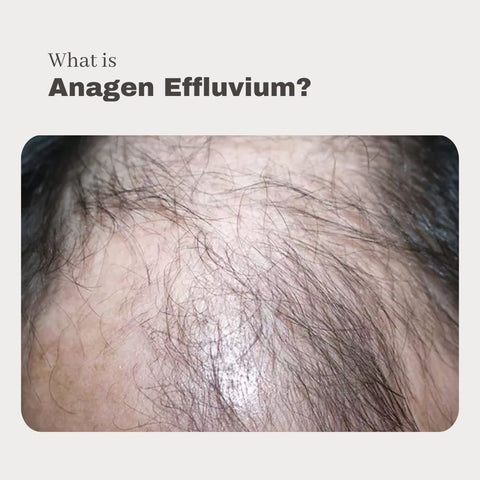
Anagen Effluvium is a type of hair loss that occurs during the anagen phase, which is the growth phase of the hair cycle. It is caused by a sudden cessation of hair growth due to an internal or external injury to the hair follicles. This injury leads to damage within the hair canal and causes the hair strands to become weak and brittle, resulting in rapid hair loss. The hair fall is usually massive, with up to 85% of the follicles in the growth phase affected, and can occur within a few days to a few weeks after exposure to the trigger. Anagen Effluvium can be caused by a variety of factors, including chemotherapy, autoimmune disorders such as alopecia, or exposure to toxic levels of certain substances like lead and arsenic.
Causes and risk factors of Anagen Effluvium

Anagen effluvium can be caused by a variety of factors that disrupt the natural growth cycle of hair follicles during the anagen (growth) phase. Some common causes and risk factors are:
-
Chemotherapy: Some chemotherapy drugs used to treat cancer target rapidly dividing cells in the body, including hair follicles. This can cause widespread hair loss, including scalp, brows, eyelashes, and body hair.
-
Radiation therapy: Like chemotherapy, radiation therapy used to treat cancer can damage hair follicles, resulting in hair loss in the treated area.
-
Toxin exposure: Heavy metals, toxic chemicals, and environmental pollutants can all damage hair follicles and disrupt the normal hair growth cycle.
-
Medications: Anagen effluvium can be caused as a side effect of certain antibiotics, anticoagulants, antithyroid drugs, and retinoids.
-
Severe illness or stress: Anagen effluvium can be triggered by serious illnesses, high fevers, or severe stress, which disrupt the body's normal physiological processes, including the hair growth cycle.
-
Nutritional deficiencies: Inadequate intake of essential nutrients such as iron, zinc, protein, and vitamins (particularly vitamin D, B12, and biotin) can impair hair growth and cause hair loss.
-
Genetic predisposition: Some people may be predisposed to certain types of hair loss, such as anagen effluvium.
-
Autoimmune conditions: Certain autoimmune diseases, such as lupus or alopecia areata, can inflame and damage hair follicles, causing hair loss.
-
Hair treatments: Excessive use of harsh hair treatments, such as chemical relaxers, hair dyes, or hot styling tools, can harm the hair shaft and weaken it, increasing the likelihood of hair loss.
Diagnosing Anagen Effluvium
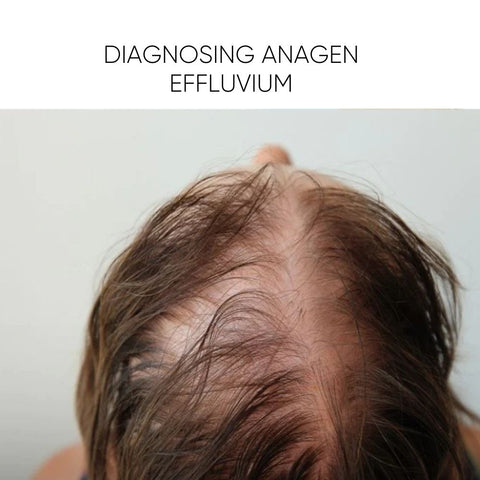
Anagen effluvium is typically diagnosed using a medical history, a physical examination, and, in some cases, additional tests or evaluations. Here's how the diagnosis process could unfold:
-
Medical History: The healthcare provider will start by asking detailed questions about the cause, duration, and pattern of hair loss. They may inquire about any recent illnesses, medications, treatments, or major life events that could be related to hair loss.
-
Physical Examination: A thorough examination of the scalp and hair follicles will be performed to determine the extent and characteristics of the hair loss. The healthcare provider may look for signs of inflammation, scarring, or other abnormalities that point to an underlying cause.
-
Pull Test: During a pull test, the healthcare provider gently tugs on a small cluster of hairs to see how many can be easily removed. The weakened hair shafts in anagen effluvium may make a large number of hairs fall out more readily than usual.
-
Microscopic Examination: A microscopic examination of the hair shafts and scalp may be performed to detect abnormalities such as hair shaft defects or signs of inflammation, infection, or hair follicle damage.
-
Blood Tests: In order to rule out underlying medical disorders or nutritional deficiencies that may be linked to hair loss, blood tests may be required. Thyroid function tests, iron and vitamin levels, complete blood counts (CBCs), and other pertinent laboratory tests may be part of these examinations.
-
Scalp Biopsy: In some cases, a scalp biopsy may be required to obtain a small sample of scalp tissue for microscopic analysis. This can help confirm the diagnosis and reveal any underlying conditions or abnormalities affecting the hair follicles.
-
Specialised Tests: Additional tests or evaluations may be required depending on the suspected cause of anagen effluvium. For example, if chemotherapy-induced hair loss is suspected, the healthcare provider may request imaging tests or consult with an oncologist to assess the overall treatment plan.
Differences between Anagen Effluvium and Telogen Effluvium

Anagen effluvium and telogen effluvium are both types of hair loss, but they differ in several important ways, including their underlying causes, the phases of the hair growth cycle affected, and the patterns of hair shedding. Here are the primary distinctions between anagen effluvium and telogen effluvium:
-
The phase of Hair Growth Cycle: Anagen Effluvium: Anagen effluvium occurs during the anagen phase of the hair growth cycle, which is the active growth stage. It is the sudden cessation of hair growth followed by the shedding of actively growing hairs. Telogen Effluvium: Telogen effluvium occurs during the telogen phase of the hair growth cycle, which is the resting period. It is characterised by the premature transition of hair follicles into the telogen phase, as well as the shedding of resting hair.
-
Underlying Causes: Anagen Effluvium: Anagen effluvium is frequently caused by factors that disrupt the normal functioning of hair follicles during the anagen phase, such as chemotherapy, radiation therapy, or exposure to certain toxins or drugs. Telogen Effluvium: Stress, hormonal changes (such as those brought on by pregnancy, childbirth, or menopause), nutritional deficiencies, medications, or underlying medical conditions are some of the triggers that can cause a synchronised shedding of resting hairs.
-
The pattern of Hair Shedding: Anagen Effluvium: This condition is characterised by more abrupt and severe hair shedding, which frequently leads to extensive hair loss. The affected hairs may appear broken or damaged because they shed prematurely during the active growth phase. Telogen Effluvium: Hair shedding is typically more gradual and diffuse. It may cause increased shedding of hair when brushing or washing, but significant bald patches are uncommon. The shedding may take place several months after the triggering event.
-
Regrowth Potential: Anagen Effluvium: Depending on the underlying cause, anagen effluvium-induced hair loss may be reversible once the triggering factor is removed or resolved. Hair follicles usually have the ability to regrow hair once the anagen phase resumes. Telogen Effluvium: Telogen effluvium is frequently reversible, and hair usually regrows after the underlying cause is addressed or resolved. The hair growth cycle resumes its normal pattern, with new hairs entering the anagen phase and replacing shed hairs.
Treatment available for anagen effluvium

The primary treatment options for anagen effluvium are to address the underlying cause and promote hair regrowth. Here are some approaches that could be considered:
-
Oral medication: This involves the use of drugs such as Minoxidil, Finasteride, and Dutasteride to promote hair growth and prevent further hair loss.
-
Topical medication: This involves the use of lotions, creams, and serums that can be applied directly to the scalp to encourage hair growth.
-
PRP: Platelet-rich plasma (PRP) therapy is one of the treatments that can be used to treat Anagen Effluvium. PRP is a type of treatment that uses a patient's own blood, which is processed to concentrate the platelets and growth factors. A doctor or hair specialist should be consulted to determine if PRP therapy is a suitable option for the individual's specific case of Anagen Effluvium.
-
Cosmetology: This involves the use of hair transplantation, hair restoration, and scalp micro pigmentation to conceal hair loss.
-
Supportive treatments: This may include good nutrition, stress management, and medications to treat underlying medical conditions that may be contributing to hair loss.
-
Lifestyle changes: Making changes to lifestyle such as avoiding exposure to harmful chemicals, maintaining a healthy diet, and reducing stress can help prevent Anagen Effluvium and promote hair growth.
It is important to note that treatment options vary depending on the cause of Anagen Effluvium, and an accurate diagnosis is necessary before starting any treatment regimen. Consultation with a doctor or a hair specialist is recommended. Now you can consult a dermatologist online who will look into your underlying scalp and hair condition and recommend personalized treatment plans delivered directly to your doorstep.
Medical treatments for Anagen Effluvium

Medical treatments for anagen effluvium primarily aim to promote hair regrowth and address any underlying conditions that may be causing hair loss. While anagen effluvium typically resolves on its own after the underlying cause is addressed, certain medical interventions may aid in regrowth and hair health. Here are some medical treatments that could be considered:
-
Minoxidil (Rogaine) is an over-the-counter topical medication that has been approved by the FDA to treat androgenetic alopecia (pattern hair loss). It may also help with hair regrowth in certain cases of anagen effluvium. Minoxidil increases blood flow to the scalp and stimulates hair follicles to enter the anagen phase, which results in thicker, longer hair growth. It is usually applied directly to the scalp once or twice a day.
-
In some cases of anagen effluvium caused by inflammatory conditions such as alopecia areata or lupus, corticosteroid injections into the scalp may help reduce inflammation and promote hair regrowth. These injections are usually given by a dermatologist and can be repeated at regular intervals as needed.
-
Topical corticosteroid creams or solutions may be prescribed to reduce scalp inflammation and irritation in cases where an underlying inflammatory condition is causing anagen effluvium. These medications are applied directly to the affected scalp areas and are usually only used for a short period of time to reduce the risk of side effects.
-
Anthralin (Dithranol) is a topical medication used to treat certain inflammatory skin conditions, including psoriasis. It may also help promote hair regrowth in some cases of anagen effluvium. Anthralin is typically applied to the scalp for a short period and then washed off to avoid irritation.
-
In cases of anagen effluvium caused by autoimmune conditions such as alopecia areata, systemic immunosuppressive medications may be prescribed to suppress the immune system's response and reduce inflammation. These medications are usually prescribed by a dermatologist or rheumatologist and can be used in conjunction with other treatments.
-
A concentrated solution of platelets derived from the patient's own blood is injected into the scalp to promote hair growth. While more research is needed to determine its efficacy for anagen effluvium, some studies indicate that Platelet-Rich Plasma (PRP) therapy may aid in hair regrowth in certain cases of hair loss.
It is important to note that the efficacy of these medical treatments for anagen effluvium differs depending on the underlying cause and individual factors. Consultation with a healthcare provider or dermatologist is necessary to determine the best treatment options based on the cause and severity of hair loss. They can advise on the benefits, risks, and potential side effects of each treatment and assist in the development of a personalised treatment plan based on individual needs and circumstances.
Natural remedies and their effectiveness

Natural remedies for anagen effluvium can supplement medical treatments while also improving overall scalp and hair health. While scientific evidence for the efficacy of these remedies in treating anagen effluvium is limited, some natural remedies have long been used to promote hair growth and reduce hair loss. Here are some natural remedies with potential effectiveness:
-
Essential Oils: Rosemary oil, peppermint oil, lavender oil, and cedarwood oil have all been traditionally used to promote hair growth and scalp health. These oils may have anti-inflammatory, antimicrobial, and stimulating properties, which can benefit hair follicles. They can be diluted with a carrier oil (such as coconut or jojoba oil) and massaged into the scalp.
-
Aloe Vera: The enzymes in aloe vera gel may stimulate hair growth and relieve scalp irritation. Applying aloe vera gel to the scalp and hair can help reduce inflammation, improve circulation, and promote hair follicle health. It can be used as a leave-in treatment or combined with other products to make a hair mask.
-
Coconut Oil: Coconut oil contains fatty acids and antioxidants that can nourish the scalp and strengthen hair. Massage coconut oil into the scalp and hair to promote hair health, reduce breakage, and prevent moisture loss. It can be used as a pre-shampoo treatment or left on overnight and then washed the next day.
-
Onion Juice: Onion juice contains sulphur compounds that may promote hair growth and blood circulation to the scalp. Applying onion juice to the scalp and leaving it on for a short time before washing it off may aid in hair regrowth. However, onion juice can be irritating to the skin and have a strong odour.
-
Green Tea: Antioxidants and polyphenols found in green tea may have anti-inflammatory and hair-stimulating properties. After shampooing, rinsing the hair with cooled green tea may help soothe the scalp, lessen inflammation, and encourage hair growth.
-
Scalp Massage: Applying light pressure to the scalp can help enhance blood flow, activate hair follicles, and encourage calmness. The general health of the scalp and hair may be supported by regular scalp massage, whether or not essential oils or carrier oils are added.
While using natural remedies to treat hair and scalp health can be beneficial, it is important to use caution and see a dermatologist or healthcare professional first, especially if you have underlying medical conditions, are pregnant, or are nursing a baby. Furthermore, different people may respond differently to natural remedies, and they may not work for everyone. If you are experiencing significant hair loss or have concerns about your hair's health, you should seek professional medical advice to ensure a proper diagnosis and treatment.
Role of supplements in hair regrowth
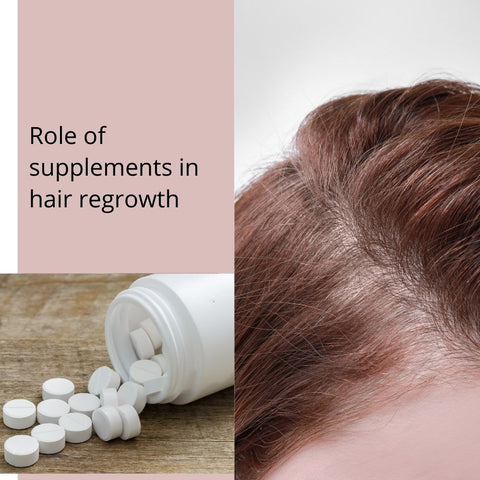
Supplements can help promote hair regrowth by providing essential nutrients needed for overall scalp and hair health. While supplements alone may not be enough to treat severe hair loss or underlying medical conditions that cause hair loss, they can supplement a healthy diet and lifestyle and promote optimal hair growth. Here are some important nutrients commonly found in supplements that may help promote hair regrowth:
-
Biotin (Vitamin B7): Biotin is a water-soluble vitamin that is essential for the production of keratin, the protein that makes up the structure of hair. Biotin supplements are often recommended to support healthy hair growth and may help improve the strength and thickness of the hair shaft.
-
Vitamin D: Vitamin D is essential for maintaining healthy hair follicles and may influence hair growth cycles. Low vitamin D levels have been linked to hair loss, so supplementation may be beneficial, particularly for those with deficiencies.
-
Iron: Iron deficiency, also known as anaemia, is a common cause of hair loss, especially among women. Iron is necessary for delivering oxygen to the hair follicles and promoting healthy hair growth. Individuals with iron deficiency anaemia may benefit from iron supplements to promote hair regrowth.
-
Zinc: Zinc is involved in cell division, tissue repair, including the restoration of damaged hair follicles, and the synthesis of DNA and RNA. Zinc deficiency has been linked to hair loss, so supplementing with zinc may help support hair growth and prevent further hair loss.
-
Vitamin E: Rich in antioxidant properties, vitamin E aids in preventing oxidative damage to cells, including hair follicles. It may also improve blood circulation to the scalp, which is important for delivering nutrients to the hair follicles. Vitamin E supplements or topical applications may help support healthy hair growth.
-
Omega-3 Fatty Acids: Rich in anti-inflammatory qualities, omega-3 fatty acids can help soothe scalp inflammation and promote healthy hair growth. They can be found in fish oil and some plant-based foods like flaxseed and walnuts. Omega-3 supplements may help people with inflammatory scalp conditions that cause hair loss.
-
Protein: Building and mending tissues, including hair follicles, depend on protein. Protein supplements may be helpful for people who do not consume enough protein in their diet, as maintaining healthy hair growth depends on an adequate protein intake.
Although supplements can supply these vital nutrients, it is crucial to keep in mind that a balanced diet and healthy lifestyle are still preferable. It is also important to follow recommended dosages and speak with a healthcare professional before beginning any new supplement regimen, especially if you have underlying medical conditions or are taking medication, as an excessive intake of some vitamins and minerals can be harmful. A medical professional can offer advice on whether supplements are suitable for your particular needs and suggest particular products based on your nutritional status and hair health objectives.
Dermatologist view on anagen effluvium?

Anagen Effluvium is a type of hair loss that can occur as a result of chemotherapy, but it is often a reversible condition. Typically, hair regrowth can occur within 1 to 3 months after chemotherapy is stopped, as long as the scalp is allowed to heal and recover. However, it is important to note that the effects of Anagen Effluvium can vary greatly between individuals and depend on a range of factors, including the type and dose of medication used. In some cases, Anagen Effluvium may occur in combination with Telogen Effluvium, leading to complete baldness. Hair loss from chemotherapy typically begins at the crown and sides of the scalp and may be inconsistent in the early stages. The hair that regrows after treatment may have a different texture, colour, or wave pattern than before.
To determine the cause of hair loss, a thorough physical examination is necessary. This may include tests such as the hair pull test to differentiate between Anagen Effluvium and Telogen Effluvium. Light microscopy may also be used to make this distinction. Fortunately, Anagen Effluvium is often reversible with proper hair care, although the use of a wig can be helpful during this temporary period. Efforts are being made to develop hair protection remedies that will minimise hair loss during chemotherapy, but it is important to be prepared for the possibility of hair loss. A positive attitude and the support of professionals can help individuals navigate this challenging time and minimise the impact of hair loss on their lives.
Symptoms of Anagen Effluvium
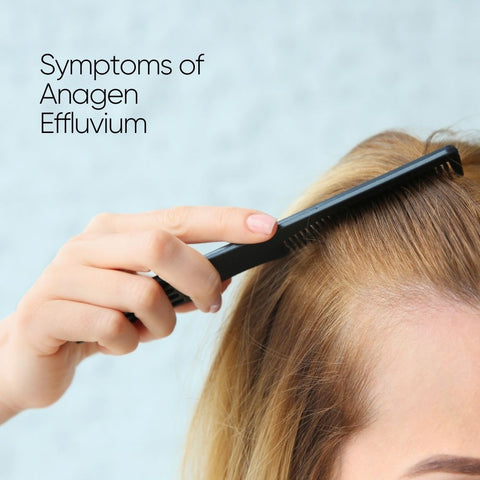
These are some common symptoms of Anagen Effluvium:
-
Sudden and rapid hair loss, affecting mostly the scalp and extending to other parts of the body, including eyebrows, eyelashes, and body hair
-
Distress and anxiety related to hair loss
-
Changes in hair colour and texture
-
Weak and brittle hair strands that break off easily
-
Massive hair loss, with up to 85% of follicles in the growth phase affected
-
It occurs within a few days to a few weeks after exposure to the trigger
-
Can occur in patients receiving chemotherapy, those with autoimmune disorders such as alopecia, or those exposed to toxic levels of certain substances like lead, boric acid, and arsenic.
It is significant to remember that the degree of anagen effluvium symptoms can vary and can be affected by a number of factors, including the underlying cause, a person's genetic makeup, and their general state of health. If you are experiencing significant hair loss or changes in the appearance of your hair, you should see a healthcare provider or dermatologist for an accurate evaluation and diagnosis. They can assist in determining the underlying cause of your symptoms and recommending appropriate treatment options based on your specific requirements.
Can diet help with anagen effluvium hair regrowth?
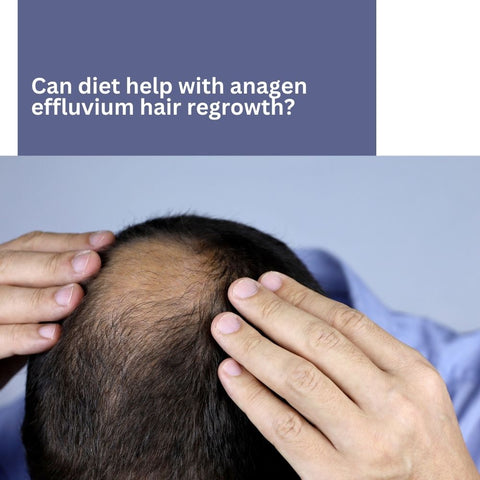
Yes, diet can play a role in supporting hair regrowth in cases of anagen effluvium. Diet can play a role in promoting hair growth during anagen effluvium, a type of hair loss that occurs due to damage to the hair follicles. A well-balanced diet rich in vitamins and minerals essential for hair health, such as biotin, iron, and vitamins B and D, can help with hair regrowth. Additionally, reducing stress and avoiding foods that can trigger inflammation, such as processed food and sugar, may also be beneficial. However, it is important to keep in mind that diet is only one factor that affects hair growth and that it may not be a cure for anagen effluvium. Consulting with a dermatologist or healthcare provider is recommended to develop a comprehensive treatment plan for hair loss.
Preventive measures and lifestyle changes

Preventive measures and lifestyle changes can help maintain overall scalp and hair health, potentially lowering the risk of developing conditions such as anagen effluvium. While some causes of anagen effluvium, such as chemotherapy, may not be preventable, certain practices can help to maintain hair health and reduce the risk of hair loss. Here are some precautionary measures and lifestyle changes to consider:
-
Maintain a Balanced Diet: A well-balanced diet high in vitamins, minerals, proteins, and essential fatty acids can benefit overall health, including the scalp and hair. Include a wide range of fruits, vegetables, whole grains, lean proteins, and healthy fats in your diet.
-
Stay Hydrated: Drink plenty of water every day to keep your body hydrated and the scalp and hair follicles hydrated.
-
Manage Stress: Chronic stress can contribute to hair loss, so it's important to manage stress levels through relaxation techniques such as meditation, deep breathing exercises, yoga, or hobbies that promote relaxation.
-
Gentle Hair Care: Avoid harsh hair treatments, excessive heat styling, tight hairstyles, and the use of chemical products that can harm the hair shaft and scalp. Use gentle, sulfate-free shampoos and conditioners tailored to your hair type.
-
Protect Hair from Environmental Damage: Limit your exposure to environmental pollutants, UV radiation, and harsh weather conditions that can harm your hair and scalp. Consider wearing hats or scarves to protect your hair and scalp when spending time outside.
-
Avoid Smoking and Excessive Alcohol Consumption: Smoking and excessive alcohol consumption can be harmful to overall health, including hair health. Quitting smoking and limiting alcohol consumption can improve overall well-being and promote hair health.
-
Exercise Frequently: Frequent physical activity enhances circulation, lowers stress levels, and improves general health, all of which have an indirect positive impact on the health of the scalp and hair.
-
Get Enough Sleep: Aim for 7-9 hours of quality sleep per night to promote overall health and allow the body to repair and regenerate, including the scalp and hair follicles.
-
Limit Your Use of Hot Styling Tools: Overuse of hot styling tools like flat irons, curling irons, and blow dryers can damage the hair shaft and cause breakage. Use these tools on low heat and limit their use whenever possible.
-
Consult a Healthcare Provider: If you notice significant hair loss or changes in your hair's appearance, see a healthcare provider or dermatologist for an evaluation and treatment recommendations. Early intervention can help prevent additional hair loss and promote regrowth.
By incorporating these preventive measures and lifestyle changes into your daily routine, you can improve scalp and hair health while lowering your risk of developing conditions like anagen effluvium.
Final Thoughts: Navigating Through Anagen Effluvium
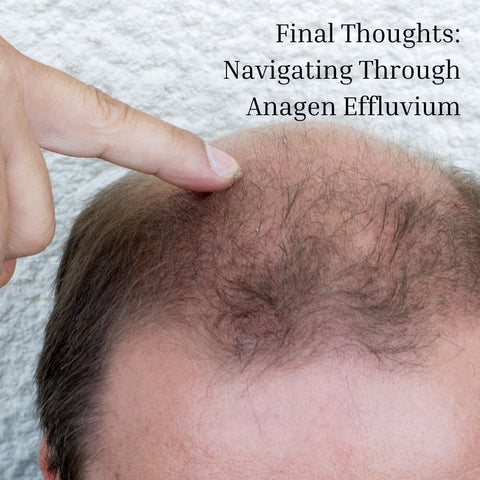
Navigating anagen effluvium can be difficult, but with the right knowledge, support, and guidance, you can effectively manage this condition. Here are some final points to consider:
-
Educate Yourself: Understanding the causes, symptoms, and treatment options for anagen effluvium can help you make better decisions about your hair's health. Take the time to learn about the condition and ask questions during consultations with your healthcare provider.
-
Seek Professional Help: If you are experiencing significant hair loss or changes in the appearance of your hair, do not hesitate to consult a healthcare provider or dermatologist. They can perform a thorough evaluation, provide an accurate diagnosis, and recommend treatment options that are specific to your needs.
-
Addressing Underlying Causes: Identifying and treating any underlying causes of anagen effluvium is critical for successful management. Whether it is stopping a medication, addressing a nutritional deficiency, or managing a medical condition, addressing the underlying cause can help promote hair regrowth and prevent further loss.
-
Follow Treatment Recommendations: If treatment is recommended, make sure to follow your healthcare provider's instructions exactly. This could include taking prescribed medications, making lifestyle changes, or implementing specific hair care practices to improve scalp and hair health.
-
Patience: Hair regrowth takes time, so be patient and consistent with your treatment plan. It may take several weeks or months to see visible improvements, but with perseverance, you can achieve positive results.
-
Take Care of Yourself: Improve your overall health and well-being by adopting healthy lifestyle habits, managing stress, eating a balanced diet, staying hydrated, and getting enough exercise and sleep. A healthy body and mind can promote optimal hair growth and quality of life.
-
Seek Support: Coping with hair loss can be emotionally difficult, so do not be afraid to seek help from friends, family, or support groups. Sharing your experiences and feelings with others who understand can bring comfort and encouragement along the way.
The experience that each person has with anagen effluvium is different, so keep in mind that what works for one person might not work for another. Be patient, positive, and confident in your ability to get through this difficult time. With perseverance and the right support, you can overcome anagen effluvium and enjoy a healthier, happier relationship with your hair.









































